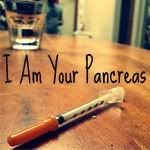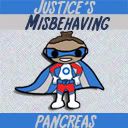Friday, July 30, 2010
D-Feast Friday --- A Review
9:46 PM
I really don't have any recipes to contribute because I don't know the carb counts of most of the things we eat. We just kind of wing it around here . . .
But . . .I did have a chance to make Lorraine's Special Fried Rice last weekend and it was pretty fabulous!
Jim and I both went back for seconds.
Ok, so my pictures are not as pretty as Lorraine's but here is my attempt at pictures of our Chicken Fried Rice -
Our family gave it 4 Thumbs Up - Emma was our lone hold out only because as she put it "broccoli makes me gag!". Ehhh - I'll leave the broccoli out of hers next time for the 5 Thumbs Up!
But . . .I did have a chance to make Lorraine's Special Fried Rice last weekend and it was pretty fabulous!
Jim and I both went back for seconds.
Ok, so my pictures are not as pretty as Lorraine's but here is my attempt at pictures of our Chicken Fried Rice -
 |
| Chopping Broccoli (& other yumminess) |
 |
| The Final Product |
 |
| Looks Good!! |
 |
| Most Important - Nate Loved It!! |
Our family gave it 4 Thumbs Up - Emma was our lone hold out only because as she put it "broccoli makes me gag!". Ehhh - I'll leave the broccoli out of hers next time for the 5 Thumbs Up!
Thursday, July 29, 2010
A picture is worth 1000 words . . .
3:53 PM
Last week I was asked to take part in study being conducted by Schlesinger and Associates. They were looking for caregivers of children with diabetes (CWD). Hey - that's me! I have a CWD so I was more than happy to participate.
They asked me to make a collage about diabetes and bring it to the meeting. So, the above picture is what I made and took into the meeting. Pretty cute - no? I mean if you have to make a picture about diabetes - it's pretty cute. Oh wait - maybe it's just my adorable son, Nate that makes it so cute!! :)
Anyway, I have no idea who or what the research was for but I hope that I was able to help in some way because ONE DAY I WOULD LOVE TO SAY THAT MY SON USED TO HAVE DIABETES!
Tuesday, July 27, 2010
As promised . . .
10:18 PM
and for Lorraine . . .
Seriously, thank you all for your words of support and encouraging comments. I let it all out and am feeling much better today. And . . . I am very pleased to announce that after my grandmother prayed a good, long prayer for me she has forgiven me for saying BULLSHIT in my blog - - - and I could not be happier! :)
For all the new peeps that commented on this post --- thank you - thank you - thank you. After a good nights sleep tonight I fully intend on stopping by your blogs and show you the same amount of love you showed me today, Thanks again!!
Monday, July 26, 2010
Why I Still Cry . . .
9:13 PM
Last week we (The Houston Five + Poppa DeJulius) attended the JDRF Walk to Cure Diabetes Kick Off Dinner. I promised myself - no crying! Dang! As soon as the Nick Jonas video started playing - I was CRYING! [Click HERE to see video]
And then again when all of these young children were on stage . . .
We have Elise from Death of a Pancreas , Liam from Sticking it to Diabetes , and Miss J and Miss G from 2 Green Eyed Girls (& their daddy too)
Look at these cuties. . .
Why do I still cry and get so emotional when discussing diabetes? Why?
I have friends and family members that have had T1 for years and are totally fine. I read blogs written by men and women that have had T1 for as long as they can remember and they are living happy, healthy, and successful lives. So, WHY do I CRY?
Well, sit down just a spell and let me tell you why -
Because diabetes SUCKS. That's right I said it - it sucks.
Sometimes I wonder if I cry more for me or for Nate? Well, some days I think I do cry for me and some days I cry for Nate.
On September 17th of 2009 - everything changed in my life. Everything.
My life is hard. Yep - I said it. It's hard. Not easy --- not a lot of easy over here at the Houston house.
Sometimes I just get sad. Sometimes I get mad. Pretty damn mad! Sometimes I just think - you know what? This is bullshit! Yep - I said bullshit.
It's BS that I have to use a lancet to cut my son's finger 12 times a day, make him bleed, so that I can test his blood glucose. Yes, that is BS. Nate doesn't even flinch - he's so strong and so tough and he is ONLY 2 years old. That is BS. If you are reading this and your 2-year old does NOT have diabetes - what do you think your child would do if you cut his finger and made him bleed even 1 time?
It's BS that a drug that smells like a big band-aid is infused into my son's body all day long and that stinky drug called insulin keeps him alive. It's BS that if I make just 1 tiny mistake with that insulin pumping through his body - he could DIE. See what I mean - total BS!
It's BS that I NEVER sleep. Seriously - Never! Anyone that knows me well knows that is not a good thing. It is my job to keep my son alive and it is a 24/7 job.
It's BS when people ask me - - - 'Why are you still checking him at night?' or 'When will you be able to stop checking him all night?'. I want to ask them when they would stop?!?! Would that be rude? If your child had a disease that could potentially kill them - when would you stop checking?
It's BS when people tell me --- Oh, my cousin's brother's son was diagnosed with T1 a couple of years ago. They're fine. Everything is fine. They have it totally under control. OK - calling BS on that. First of all if you tell me 'they have it under control' then you have no idea what the heck you are talking about. A person with diabetes can have good control but there is NO such thing as total control. Everything is a roller coaster with T1 especially with children. Another big fat BS when you tell me that 'they are fine'. Really? You know that for a fact? Or do you just assume because everything looks ok from the outside that everything is fine? I can pretty much GUARANTEE that everything is not fine on the inside --- I don't care how long it's been since the diagnosis there are still good days and bad days. I can GUARANTEE that every mom of a T1 still cries every now and then ---- if she doesn't then there is something wrong!!
It's BS that I am begging people for money to support the JDRF because MY son has diabetes. It's BS because I am asking (begging) my friends and my family to walk with us, support us and donate but I feel like I'm asking strangers. It's BS because I never see my friends anymore and when I do I'm sure they are sick and tired of me and my tired ass begging them to support MY cause. But what is NOT BS is that my son needs a cure and that is why I will keep begging anyone and everyone to help.
It's BS that I miss my normal, boring life. I miss my friends. I miss girls night out. I miss hanging out and chatting with other moms. Even when I try to do these things my brain is such mush from all of the numbers swirling around and the lack of sleep I feel like I'm not really there.
It's BS that I have to weigh, measure and count every little thing that goes into Nate's mouth. Seriously - it is SO much harder than it sounds.
It's BS that I cannot get insurance for my children. Yes, I know there are options out there but the options are BS.
It's BS that my 6 year old asked me the following question "Mom, if Nate has diabetes and Sophie has Crohn's --- what am I going to get?". That is BS.
Here's why I still cry - - - because when I look at my son he looks so healthy and beautiful but I know that his BG jumping all over the place. I know that that 325 that I saw on the meter this morning is BAD! It's really bad. I know that his life expectancy is shorter than you son's life expectancy --- what mom doesn't cry about that? A child's mortality is something a parent should NEVER have to think about and yet I think about it every day.
I cry because I want a cure so bad that I can almost taste it and yet somehow I won't allow myself to think about it.
I cry because I want to take this stupid disease away from my son --- I just want to grab it and take it away.
I cry because type 1 diabetes is so misunderstood and I want to tell the world all about it but when I try to discuss it all I can do is CRY.
That is all.
Tomorrow I will be back to sunshine and rainbows.
And then again when all of these young children were on stage . . .
 | ||
| Lots of Cute T1 Peeps you may know in this picture. |
Look at these cuties. . .
 |
| Liam, Elise and Nate |
Why do I still cry and get so emotional when discussing diabetes? Why?
I have friends and family members that have had T1 for years and are totally fine. I read blogs written by men and women that have had T1 for as long as they can remember and they are living happy, healthy, and successful lives. So, WHY do I CRY?
Well, sit down just a spell and let me tell you why -
Because diabetes SUCKS. That's right I said it - it sucks.
Sometimes I wonder if I cry more for me or for Nate? Well, some days I think I do cry for me and some days I cry for Nate.
On September 17th of 2009 - everything changed in my life. Everything.
My life is hard. Yep - I said it. It's hard. Not easy --- not a lot of easy over here at the Houston house.
Sometimes I just get sad. Sometimes I get mad. Pretty damn mad! Sometimes I just think - you know what? This is bullshit! Yep - I said bullshit.
It's BS that I have to use a lancet to cut my son's finger 12 times a day, make him bleed, so that I can test his blood glucose. Yes, that is BS. Nate doesn't even flinch - he's so strong and so tough and he is ONLY 2 years old. That is BS. If you are reading this and your 2-year old does NOT have diabetes - what do you think your child would do if you cut his finger and made him bleed even 1 time?
It's BS that a drug that smells like a big band-aid is infused into my son's body all day long and that stinky drug called insulin keeps him alive. It's BS that if I make just 1 tiny mistake with that insulin pumping through his body - he could DIE. See what I mean - total BS!
It's BS that I NEVER sleep. Seriously - Never! Anyone that knows me well knows that is not a good thing. It is my job to keep my son alive and it is a 24/7 job.
It's BS when people ask me - - - 'Why are you still checking him at night?' or 'When will you be able to stop checking him all night?'. I want to ask them when they would stop?!?! Would that be rude? If your child had a disease that could potentially kill them - when would you stop checking?
It's BS when people tell me --- Oh, my cousin's brother's son was diagnosed with T1 a couple of years ago. They're fine. Everything is fine. They have it totally under control. OK - calling BS on that. First of all if you tell me 'they have it under control' then you have no idea what the heck you are talking about. A person with diabetes can have good control but there is NO such thing as total control. Everything is a roller coaster with T1 especially with children. Another big fat BS when you tell me that 'they are fine'. Really? You know that for a fact? Or do you just assume because everything looks ok from the outside that everything is fine? I can pretty much GUARANTEE that everything is not fine on the inside --- I don't care how long it's been since the diagnosis there are still good days and bad days. I can GUARANTEE that every mom of a T1 still cries every now and then ---- if she doesn't then there is something wrong!!
It's BS that I am begging people for money to support the JDRF because MY son has diabetes. It's BS because I am asking (begging) my friends and my family to walk with us, support us and donate but I feel like I'm asking strangers. It's BS because I never see my friends anymore and when I do I'm sure they are sick and tired of me and my tired ass begging them to support MY cause. But what is NOT BS is that my son needs a cure and that is why I will keep begging anyone and everyone to help.
It's BS that I miss my normal, boring life. I miss my friends. I miss girls night out. I miss hanging out and chatting with other moms. Even when I try to do these things my brain is such mush from all of the numbers swirling around and the lack of sleep I feel like I'm not really there.
It's BS that I have to weigh, measure and count every little thing that goes into Nate's mouth. Seriously - it is SO much harder than it sounds.
It's BS that I cannot get insurance for my children. Yes, I know there are options out there but the options are BS.
It's BS that my 6 year old asked me the following question "Mom, if Nate has diabetes and Sophie has Crohn's --- what am I going to get?". That is BS.
Here's why I still cry - - - because when I look at my son he looks so healthy and beautiful but I know that his BG jumping all over the place. I know that that 325 that I saw on the meter this morning is BAD! It's really bad. I know that his life expectancy is shorter than you son's life expectancy --- what mom doesn't cry about that? A child's mortality is something a parent should NEVER have to think about and yet I think about it every day.
I cry because I want a cure so bad that I can almost taste it and yet somehow I won't allow myself to think about it.
I cry because I want to take this stupid disease away from my son --- I just want to grab it and take it away.
I cry because type 1 diabetes is so misunderstood and I want to tell the world all about it but when I try to discuss it all I can do is CRY.
That is all.
Tomorrow I will be back to sunshine and rainbows.
Friday, July 23, 2010
JDRF Car Magnets
6:41 PM
I LOVE these magnets and I love that all of the proceeds go to JDRF. My awesome D-Mom pal, Jill over at Diabetes Sweeties sent me one for Christmas and my mom was green with envy. She was on a mission to find one for her truck!! Now I am normally the more internet savvy one but I have to hand to to my mom --- she searched high and low and finally found the site that sells them.
You can order them at:
http://juvenilediabetesmagnets.homestead.com/
Christi and her mom, Laura (awesome name) will hook you up!!
I'm so glad she did because now our trucks look like this:
GaGa's Truck
My truck
Thursday, July 22, 2010
D-Feast Friday
11:02 PM
FAIL.
I am super excited about D-Feast Friday and I am super sad that I am not participating. Here's the deal - - -
I've been sick all week, I've got the diabetes blues and I am pretty sure there is not a recipe that I can offer that doesn't spike Nate's bg to the MOON! Even the bacon and eggs he had this morning sent him off the charts - - - I give up!
Maybe he's getting sick - I don't think so. Maybe he's growing - could be! Maybe diabetes sucks - yep I think that's it!!
I am already seeing fantastic recipes popping up on my blog roll so please take a look on the left hand side of my blog and check out all of the awesome bloggers that are participating!
Thank you Karen, Lorraine and Elizabeth for coming up with D-Feast Friday - you girls are AMAZING!!
I am super excited about D-Feast Friday and I am super sad that I am not participating. Here's the deal - - -
I've been sick all week, I've got the diabetes blues and I am pretty sure there is not a recipe that I can offer that doesn't spike Nate's bg to the MOON! Even the bacon and eggs he had this morning sent him off the charts - - - I give up!
Maybe he's getting sick - I don't think so. Maybe he's growing - could be! Maybe diabetes sucks - yep I think that's it!!
I am already seeing fantastic recipes popping up on my blog roll so please take a look on the left hand side of my blog and check out all of the awesome bloggers that are participating!
Thank you Karen, Lorraine and Elizabeth for coming up with D-Feast Friday - you girls are AMAZING!!
Sunday, July 18, 2010
Dear Insurance Companies,
8:00 AM
Saturday, July 17, 2010
More swimmers in the family . . .
8:14 AM

Nate and Sophie have been taking swim lessons from the same lady that taught me (A VERY LONG time ago).
Here is a video of Nate - he learned survival first and has now moved on to swimming. This video is of Nate floating for survival.
What does swimming do to his bg you ask?? Well, when he is swimming at home he drops like a ROCK - I'm talking CARBOPALOOZA baby (yep, I stole that word from Meri) and zero basal but when he is at swim class he goes high as a kite because he gets SO MAD!! Nothing is ever the same or easy with diabetes!!
And this is why Nate needs to be able to survive in the water (see picture below) - - -
I was watching him from the next room. He moved Barbie's pretty, pink RV over to the door, stood on his tip toes and figured out the child-proof lock on the back door. Can I just say that my girls NEVER did that!?!? NOT ONE TIME!!
Nate has never been away from me since his dx so he is a MOMMA'S BOY! All that crying is not about the swimming or the floating - - - it is about him wanting his MOMMA!!
I told Jim that I really don't think I've ever had a boy quite so smitten with me. :)
It's starting to reach stalker status - - - I can't even pee in peace. It's gotten ridiculous in a good way. I love my little momma's boy!!
Ms. Sophie loves to swim too!! Here she is with her new BFF, Hannah -
2 Little fishies!!!
Friday, July 16, 2010
Beep Beep Beep Beep Beep
8:30 AM
I seriously feel like that is all Nate's DexCom does. BEEP! I changed some settings and things have gotten better. But I had this idea while driving down the road with Nate and his DexCom was beep beep beeping!!
Since he is only 2 and still in a car seat he could not get to the receiver and even if he could I really would not want him chunking it at my head while driving! So, I would like to develop a CGM specifically designed for children (the concept would work for adults too) and make the receiver a wristwatch. With a range more like the Navigator or even further!! I (mom or T1 Peep) could be wearing the watch and when an alarm goes off I could take a quick looksie (while driving, cooking, sleeping, in a meeting, . . . whatever) and figure out a plan of action! It's quick, it's easy and it's a watch!! I mean I like a nice watch just like the next person so if you want bling on your new CGM watch - - - I think bling should be an option! Design your own CGM watch!!. Wouldn't you rather wear a blingy (or design of your choice) watch CGM rather than a spibelt?
Because here is what happened when momma did not know which alarm was going off while driving (I haven't learned the different alarm sounds just yet).
Since he is only 2 and still in a car seat he could not get to the receiver and even if he could I really would not want him chunking it at my head while driving! So, I would like to develop a CGM specifically designed for children (the concept would work for adults too) and make the receiver a wristwatch. With a range more like the Navigator or even further!! I (mom or T1 Peep) could be wearing the watch and when an alarm goes off I could take a quick looksie (while driving, cooking, sleeping, in a meeting, . . . whatever) and figure out a plan of action! It's quick, it's easy and it's a watch!! I mean I like a nice watch just like the next person so if you want bling on your new CGM watch - - - I think bling should be an option! Design your own CGM watch!!. Wouldn't you rather wear a blingy (or design of your choice) watch CGM rather than a spibelt?
Because here is what happened when momma did not know which alarm was going off while driving (I haven't learned the different alarm sounds just yet).
Oh look - it's a perfect match!!!!!!!!!!!!!!
Oops - I think I should have pulled over to figure it out. Live and Learn!
Thursday, July 15, 2010
I have another child . . . Really I do!!
3:00 PM
Ms. Emma never gets any face time on this blog so I thought I would give her a shout out. Emma just finished a great swim season with the BT Bullets!! She is one fast little swimmer!! She has been sick for the past 5 days but she wanted to swim in the championship meet anyway. She swam on Monday morning and rocked it at the meet then came home and collapsed with a 103 degree fever.
Here are some pics of Ms. Emma . . .
I love my Emma Leigh!!
Wednesday, July 14, 2010
Rockin' the bg check at 2 years old -
9:49 PM
After our perfect night that looked like this -
Nate checked his own bg today . . .
3)Make sure strip is in the PDM correctly
Nate checked his own bg today . . .
1)Take out test strip
2) Insert test strip into PDM (glucometer is built in to Nate's OmniPod PDM)
3)Make sure strip is in the PDM correctly
4)A little help from mom - getting the blood from his finger onto the strip
5)Ta-Da - Done!
Hmm - a little low! That's ok - - - pancakes for breakfast! Woot-Woot!!
Tuesday, July 13, 2010
Another new kind of fine . . .
3:23 PM
Thank you all for you words of encouragement about our insurance situation. I know we will be fine.
Insurance for Me, Jim and Emma is a done deal. Sophie and Nate are another story. I have been stockpiling test strips and insulin as best I can and I will get another 3-month supply before the coverage ends so we should be ok for a while. The hard part is that it looks like we will have to take Nate off of the OmniPod. If we have to pick our expenses --- Insulin is his life so we will have to have that! Test strips are our next priority so pumping will have to wait. Plus, Sophie's expenses are not exactly light on the pocketbook. She has a daily maintenance medicine that she has to take 3 times per day and if things don't get a lot better we may have to move on to a very expensive treatment plan for her.
I am in a good place right now. I'm not stressing or freaking out (too much) but I am very sad that we will have to stop pumping (podding). We fought so hard to get Nate on the OmniPod and goodness knows we have worked our tails off getting basals sets, ratios figured out, and correction factors correct!! Going back to shots may kill me (oh yea and I'm sure Nate won't like it too much either!).
Don't even get me started about being without the DexCom ---- no pump and no Dex. I will feel like I am stepping back into the dark ages!! --- The last statement in no way implies that people that choose not to pump or use a CGM are living in the 'dark ages' --- it is just how I will feel after having what has become such luxuries for us. :) I've become quite spoiled!
There are options out there (surely there are!) but the problem is even if we get Nate and Soph on a plan they exclude all expenses of their preexisting condition for at least a year! It is a frustrating system but it is what it is and like I said I am not going to let this get me down. We will get through this and be just fine --- just another new kind of fine!
The good news is we still have our 'beep-beep' (Nate's name for his PDM) and pods for now so I am going to enjoy the heck out of them while I can!!
Insurance for Me, Jim and Emma is a done deal. Sophie and Nate are another story. I have been stockpiling test strips and insulin as best I can and I will get another 3-month supply before the coverage ends so we should be ok for a while. The hard part is that it looks like we will have to take Nate off of the OmniPod. If we have to pick our expenses --- Insulin is his life so we will have to have that! Test strips are our next priority so pumping will have to wait. Plus, Sophie's expenses are not exactly light on the pocketbook. She has a daily maintenance medicine that she has to take 3 times per day and if things don't get a lot better we may have to move on to a very expensive treatment plan for her.
I am in a good place right now. I'm not stressing or freaking out (too much) but I am very sad that we will have to stop pumping (podding). We fought so hard to get Nate on the OmniPod and goodness knows we have worked our tails off getting basals sets, ratios figured out, and correction factors correct!! Going back to shots may kill me (oh yea and I'm sure Nate won't like it too much either!).
Don't even get me started about being without the DexCom ---- no pump and no Dex. I will feel like I am stepping back into the dark ages!! --- The last statement in no way implies that people that choose not to pump or use a CGM are living in the 'dark ages' --- it is just how I will feel after having what has become such luxuries for us. :) I've become quite spoiled!
There are options out there (surely there are!) but the problem is even if we get Nate and Soph on a plan they exclude all expenses of their preexisting condition for at least a year! It is a frustrating system but it is what it is and like I said I am not going to let this get me down. We will get through this and be just fine --- just another new kind of fine!
The good news is we still have our 'beep-beep' (Nate's name for his PDM) and pods for now so I am going to enjoy the heck out of them while I can!!
Monday, July 12, 2010
The Cost Of It All . . .
10:24 PM
1) Vet Wrap - we use this to secure Nate's OmniPod around his arm so that it doesn't get knocked off. $2.00 per roll.
2) FreeStyle Flash Meter - you can never have too many meters around the house! Usually can get these free because the companies that make them make their money off of the test strips not the meters.
3) Glucagon (kit) Glucagon is used to treat insulin coma or insulin reaction resulting from severe hypoglycemia (low blood sugar). Glucagon is used in emergency situations when the patient is unconscious. Within the glucagon kit is a vial of powdered glucagon and a syringe filled with liquid (diluent). The dose is prepared immediately before injection. We have 1 in the kitchen, 1 with the D supplies and we have 1 with us in Nate's bag at all times. The cost for the 3 kits is approximately $255.00 - - - they expire after 1 year.
4) BD Ultra Fine Syringes for insulin injections. I think these cost about $20 per box.
5) OmniPod Personal Diabetes Manager (PDM) - this is what we test Nate's blood sugar on and dose all of his insulin. It control every aspect of Nate's insulin pump. This is our back-up PDM in the rare case our current PDM malfunctions we have a back-up to keep us rolling. Ehhhh . . . I really don't remember - - -I think this costs about $500 or $600. Insurance paid 100% of Nate's OmniPod but they do not pay for an extra PDM.
6) Precision Xtra Blood Ketone Strips - we test Nate for ketones when his bg goes above 250, if he is sick or shows any sign of DKA. These little strips are like buying gold - - - the cost is about $50.00 for a box of 10 and our insurance does not cover these. The boxes that we do have were given to us by a very nice CDE at Children's Medical Center of Dallas.
7) Accu-Check MultiClix Lancets - these are what we use to prick Nate's finger to draw blood for his bg checks. $73.27 for a 3 month supply(we currently pay about $17).
8) OmniPod Pods - the Pod holds and delivers Nate's insulin it has adhesive so we can apply it almost anywhere on his body. Obviously from all of my previous post - - - we prefer to apply it to his bum area. We also use his arm, leg and back. We change Nate's pod every 2-3 days. Each pod is $30 -- we order 5 boxes of 10 at a time and pray that they will last 3 months until the next shipment!!
9) FreeStyle Test Strips - these are the strips that go into the FreeStyle meter or the OmniPod PDM to test Nate's bg. These little babies cost about $1 each. We test Nate's bg anywhere from 10-14 times per day. A 3-month supply costs $942.00 (we currently pay $300).
10) Alcohol Wipes - we keep plenty of these on hand to clean Nate's fingers before a bg check and also to clean the area where we will apply his pod during a site change. $2.00 per box.
11) Johnson & Johnson Baby Oil - we sometime use this to remove the adhesive from Nate's pods on site change days. $5.00
12) Target Brand Rubbing Alcohol - also used to clean Nate's fingers and sites for pods. $2.50
13) Smith & Nephew Skin Prep Wipes - we prefer to use these more than the alcohol wipes to clean the site for Nate's pod. It has a little stick to it and helps the pod stay on better. $12 for a box of 50.
14) Smith & Nephew Uni-Solve - we prefer to use this to help remove Nate's pods. It helps remove the adhesive and loosen the pod before we take it off.
15) 3m Tegaderm - sometimes used to place over Nate's pod to keep it firmly in place. $10 for a box of 50
16) Miscellaneous Diabetes Supplies are kept in this little 2 drawer cabinet.
17) Pacifier Carrier - I use this little case to keep Nate's insulin in when we travel.
18) NOT SHOWN - Nate's insulin. We have insulin in the fridge and in his bag. We must keep it with us at ALL TIMES. Insulin keeps Nate alive. It costs about $85 per vial. We use 2 vials per month.
And I cannot forget out latest addition . . . DEXCOM!!! (Not pictured above because I've been working on this post for what feels like forever and Dex just came on Friday)
Our insurance paid 100% but I believe the cost is $800 for the receiver & transmitter and $250 for a months supply of sensors (4 sensors).
and here is a picture of Nate wearing his new CGM (I did the insertion while he was sleeping)
______________________________________________________________
Right now we are covered for most of the supplies listed above on a COBRA group plan through Jim's previous employer. Our coverage will expire on 9/30/10. Because Jim is self-employed we no longer qualify for a group plan so I've been calling around and trying to get our family covered on an individual plan. Wow - the reality of having 2 chronically ill children while searching for insurance coverage is like a huge punch right in the gut.
The same company that currently covers our family under a group plan scoffed at the thought of covering my children under an individual plan. In 3 short months my family will lose our insurance and the ability to keep our son alive and our daughter's disease comfortably under control.
We do have a few options -
The Texas High Risk pool is available for our children at the cost of approximately $450 per child per month.
CHIP - Children's Medicaid is available if we qualify. So, basically if we stop working our kids will be covered at a lower rate through Medicaid.
ObamaCare or Pre-Existing Condition Insurance Plan (PCIP) - we are still waiting to find out more details but the cost is supposed to be 1/2 the cost of the TX high risk pool insurance. Unfortunately, everything I have read says that you must be uninsured for 6 months before you can qualify. Huh? Why?
I will continue to document our journey on finding affordable health care coverage for our children. It is a frustrating process but I am up to the challenge!!
Friday, July 9, 2010
Official DX = Benign Transient Hyperphosphatasemia
7:46 PM
Nate's alkaline phosphatase results came back much lower today and all of the other results were completely normal. It looks like we have a case of Benign Transient Hyperphosphatasemia which really means that his alkaline phosphatase was elevated for no good reason but should go down and cause absolutely no problem whatsoever.
That's all I've got for now.
Thank you as always for all of the comments, prayers and support . . . it really takes a village!
That's all I've got for now.
Thank you as always for all of the comments, prayers and support . . . it really takes a village!
Wednesday, July 7, 2010
Benign Transient Hyperphosphatasemia of infancy and early childhood . . .
9:12 PM
Ummm - yea - whatever that means! I'm seriously not that sure what it is but I am sure hoping that Nate has it!
Last week we took Nate to his endo for his quarterly appointment. At his new practice they do not do a finger stick HBA1C like they did at his previous practice. They do a full blown blood draw and run 'the works' to make sure everything is on track. Nate has not had his blood drawn since his diagnosis and even at that time we were never given any information on what tests were run or what the results were.
Type 1 diabetics run the risk of several other endocrine issues so I was thrilled to get a full work up and anxious to get the results back. Almost everything looks pretty good. His A1C is down an entire point, no thyroid problems, his cholesterol is good. A few issues --- his triglyceride results are high and his HDL is low which apparently is somewhat normal for T1 children. His alkaline phosphatase results came back extremely high and when I say HIGH --- I'm not even kidding. They should be somewhere between 200 - 400 and his came back at 3,017. What does this mean? I honestly just don't know - I've been on Dr. Google all day and I can't wrap my head around all of the things that it could mean but for now Nate's dr. is running more tests which should give us more answers soon.
And . . . if all of the the test results come back normal then they think he may have a case of Benign Transient Hyperphosphatasemia.
________________________________________
Here is the information that I was sent - It's a lot to digest so please feel free to bypass. :)
Transient hyperphosphatasemia (TH) of infancy and early childhood is characterized by a marked elevation of serum alkaline phosphatase in the absence of detectable liver or bone disease, and a return to normal levels within weeks or months. The condition is thought to be benign; thus, this disorder is also called benign transient hyperphosphatasemia. Recognition of this phenomenon permits avoidance of unnecessary procedures and concerns, provided that underlying liver and bone disease are appropriately excluded.
The clinical presentation and evaluation of an infant or young child with marked elevation of serum alkaline phosphatase will be reviewed here. Evaluation of an older child or adult with elevated alkaline phosphatase, or of any individual with elevations of multiple liver enzymes, is discussed separately. (See "Alkaline phosphatase and other enzymatic measures of cholestasis" and "Approach to the patient with abnormal liver function tests".)
The prevalence of TH is not known. In a series of 260 healthy infants, three (1.5 percent) had unexplained and transient elevations in serum AP, all more than three times the upper limit of normal for the assay [14]. Similar prevalence rates were seen in a separate study in which serum alkaline phosphatase levels >1000 U/L (2.5 times the upper limit of normal) were found in 2.8 percent of healthy children under two years of age. More moderate elevations of alkaline phosphatase, between 400 and 1000 U/L, were found in 5.1 percent of the subjects [15].
Most children with TH are healthy, although TH has occurred in association with a variety of clinical conditions, including gastroenteritis, respiratory infection, failure to thrive, and asthma. TH has also been reported with viral infections such as respiratory syncytial virus [16-18], enteroviruses [19], and HIV [20]; following liver [21,22] or kidney transplant [21]; and in children receiving chemotherapy for leukemia and lymphoma [11,23]. Some of these apparent disease associations may reflect more frequent laboratory testing to monitor the underlying disease. Indeed, in the largest study that prospectively evaluated a healthy population of infants and toddlers, no association with growth parameters was found [15]. A seasonal distribution of cases has been noted in some series, with more cases identified in late summer and early fall [5,11].
Measurement of alkaline phosphatase isoenzymes by electrophoresis can be helpful if this test is available. The presence of excessive bone and liver fractions supports the diagnosis of TH and argues against primary hepatic or bone disease. (See "Alkaline phosphatase and other enzymatic measures of cholestasis".)
The possibility of rickets should be raised by low serum levels of 25-hydroxyvitamin D with low serum calcium and/or phosphorus, elevated levels of PTH, a history of risk factors for vitamin D deficiency (exclusive breast feeding without vitamin D supplementation), or typical skeletal abnormalities. Any of these findings should prompt further evaluation for rickets, with radiographs of long bones. (See "Overview of rickets in children".)
Bone pain or other bone abnormalities should be evaluated radiographically for evidence of tumor, fracture, or juvenile Paget disease (a rare autosomal recessive disorder of bone turnover associated with bone deformities and susceptibility to fracture). Limb pain also can be caused by a variety of orthopedic, infectious, rheumatic, and neoplastic disorders, as discussed separately. (See "Clinical manifestations and diagnosis of Paget disease of bone" and "Clinical assessment of the child with suspected cancer", section on 'Bone and joint pain' and "Overview of the causes of limp in children".)
Last week we took Nate to his endo for his quarterly appointment. At his new practice they do not do a finger stick HBA1C like they did at his previous practice. They do a full blown blood draw and run 'the works' to make sure everything is on track. Nate has not had his blood drawn since his diagnosis and even at that time we were never given any information on what tests were run or what the results were.
Type 1 diabetics run the risk of several other endocrine issues so I was thrilled to get a full work up and anxious to get the results back. Almost everything looks pretty good. His A1C is down an entire point, no thyroid problems, his cholesterol is good. A few issues --- his triglyceride results are high and his HDL is low which apparently is somewhat normal for T1 children. His alkaline phosphatase results came back extremely high and when I say HIGH --- I'm not even kidding. They should be somewhere between 200 - 400 and his came back at 3,017. What does this mean? I honestly just don't know - I've been on Dr. Google all day and I can't wrap my head around all of the things that it could mean but for now Nate's dr. is running more tests which should give us more answers soon.
And . . . if all of the the test results come back normal then they think he may have a case of Benign Transient Hyperphosphatasemia.
________________________________________
Here is the information that I was sent - It's a lot to digest so please feel free to bypass. :)
Transient hyperphosphatasemia (TH) of infancy and early childhood is characterized by a marked elevation of serum alkaline phosphatase in the absence of detectable liver or bone disease, and a return to normal levels within weeks or months. The condition is thought to be benign; thus, this disorder is also called benign transient hyperphosphatasemia. Recognition of this phenomenon permits avoidance of unnecessary procedures and concerns, provided that underlying liver and bone disease are appropriately excluded.
The clinical presentation and evaluation of an infant or young child with marked elevation of serum alkaline phosphatase will be reviewed here. Evaluation of an older child or adult with elevated alkaline phosphatase, or of any individual with elevations of multiple liver enzymes, is discussed separately. (See "Alkaline phosphatase and other enzymatic measures of cholestasis" and "Approach to the patient with abnormal liver function tests".)
CLINICAL PRESENTATION — TH occurs most commonly in infants and children younger than five years of age. A few adults with similar patterns have been reported [1-4]. The serum alkaline phosphatase (AP) is typically elevated four to five times the upper limit of normal, but elevations up to 20 times the pediatric upper reference limit (or 50 times the adult upper reference limit) have been described [5-7]. In most cases there are elevations in both liver and bone isoenzymes, and (rarely) in intestinal isoenzymes [5,8].
Serum AP levels gradually return to normal within two to three months but have persisted as long as six months in a few cases [9,10]. The half-life of AP ranges from 5 to 25 days, depending upon coexisting morbidities [11]. In series reporting the results of long-term follow-up, no clinical sequelae were noted up to four years after the episode of TH [12,13].The prevalence of TH is not known. In a series of 260 healthy infants, three (1.5 percent) had unexplained and transient elevations in serum AP, all more than three times the upper limit of normal for the assay [14]. Similar prevalence rates were seen in a separate study in which serum alkaline phosphatase levels >1000 U/L (2.5 times the upper limit of normal) were found in 2.8 percent of healthy children under two years of age. More moderate elevations of alkaline phosphatase, between 400 and 1000 U/L, were found in 5.1 percent of the subjects [15].
Most children with TH are healthy, although TH has occurred in association with a variety of clinical conditions, including gastroenteritis, respiratory infection, failure to thrive, and asthma. TH has also been reported with viral infections such as respiratory syncytial virus [16-18], enteroviruses [19], and HIV [20]; following liver [21,22] or kidney transplant [21]; and in children receiving chemotherapy for leukemia and lymphoma [11,23]. Some of these apparent disease associations may reflect more frequent laboratory testing to monitor the underlying disease. Indeed, in the largest study that prospectively evaluated a healthy population of infants and toddlers, no association with growth parameters was found [15]. A seasonal distribution of cases has been noted in some series, with more cases identified in late summer and early fall [5,11].
NORMAL RANGES FOR SERUM AP — Serum alkaline phosphatase (AP) activities are generally higher in children than in adults because of physiologically higher rates of osteoblastic activity. In infants, activities are approximately three times the upper reference limit for adults, peaking between one and six months of age [6]. By two years of age, serum AP levels fall to approximately twice the upper reference limit for adults (graph 1). A second peak occurs in early puberty for girls (around 12 years) and mid-puberty for boys (around 14 years), coinciding with maximum growth velocity. (See "The child with tall stature or abnormally rapid growth", section on 'Growth velocity'.)
PATHOGENESIS — The pathogenesis of TH is not well understood, as both liver and bone isoenzymes are usually increased. Several investigators have demonstrated that a fraction of both isoenzymes has a characteristic increase in electrophoretic mobility, due to increased content of sialic acid [6,11]. This observation has led to the hypothesis that the hyperphosphatasemia is caused by excessive sialylation of alkaline phosphatase (AP), which slows clearance of the isoenzymes.
The cause of the increased sialylation remains uncertain. By definition, TH is not caused by vitamin D deficiency. However, one hypothesis is that TH develops because there is increased production of AP during a period of catch-up growth after weight loss or vitamin D insufficiency, at a rate that overwhelms the mechanisms that normally desialylate the enzyme [11]. If so, children with TH might display subclinical vitamin D insufficiency at the time of diagnosis. However, this was not the case in one series of healthy infants and children, in which there was no difference in serum levels of vitamin D, parathyroid hormone, calcium, or phosphorus among subjects with TH as compared to those with normal AP levels [15].EVALUATION AND MANAGEMENT — Awareness of the entity of TH can avoid unnecessary tests in infants and children with this disorder. A careful history, physical examination, and abbreviated laboratory evaluation are usually sufficient to rule out other causes of the elevated alkaline phosphatase (AP).
History — The clinician should inquire about bone disease (unexplained fractures, family history of bone disease, or complaints of bone pain); symptoms suggestive of liver disease (right upper quadrant pain, pruritus, steatorrhea, or dark-colored urine); drugs; renal disease; and nonspecific symptoms including anorexia, weight loss, fever, and lethargy.
Risk factors for nutritional rickets should be assessed, including exclusive breast feeding or intake of less than one liter of vitamin D-fortified formula or milk daily, dark skin pigmentation, low exposure to sunlight, or prematurity. These infants and children are at risk for rickets unless given vitamin D supplements of at least 400 IU daily. (See "Overview of rickets in children".)Physical examination — The patient should be examined for deformities, tenderness, or other abnormalities of bone, including skeletal abnormalities associated with rickets (beading at the costochondral junction or bowing of long bones) and bone tenderness. The examination should also include assessment for hepatomegaly, splenomegaly, liver tenderness, scleral icterus, jaundice, and stigmata of chronic liver disease (palmar erythema, spider telangiectasia, clubbing, caput medusae).
Laboratory testing — Initial laboratory testing should include serum aspartate aminotransferase, alanine aminotransferase, bilirubin, calcium, phosphorus, 25-hydroxyvitamin D (calcidiol), parathyroid hormone (PTH), blood urea nitrogen, and creatinine. Either gamma-glutamyl transpeptidase (GGT) or 5'-nucleotidase should also be measured to further exclude liver disease.
A normal result for each of these tests is adequate to establish a provisional diagnosis of TH in an otherwise healthy infant or young child. Of note, the serum GGT activity is six to seven times the upper limit of the adult reference range in normal full-term neonates; levels decline and reach adult levels by five to seven months of age [24].Measurement of alkaline phosphatase isoenzymes by electrophoresis can be helpful if this test is available. The presence of excessive bone and liver fractions supports the diagnosis of TH and argues against primary hepatic or bone disease. (See "Alkaline phosphatase and other enzymatic measures of cholestasis".)
The possibility of rickets should be raised by low serum levels of 25-hydroxyvitamin D with low serum calcium and/or phosphorus, elevated levels of PTH, a history of risk factors for vitamin D deficiency (exclusive breast feeding without vitamin D supplementation), or typical skeletal abnormalities. Any of these findings should prompt further evaluation for rickets, with radiographs of long bones. (See "Overview of rickets in children".)
Bone pain or other bone abnormalities should be evaluated radiographically for evidence of tumor, fracture, or juvenile Paget disease (a rare autosomal recessive disorder of bone turnover associated with bone deformities and susceptibility to fracture). Limb pain also can be caused by a variety of orthopedic, infectious, rheumatic, and neoplastic disorders, as discussed separately. (See "Clinical manifestations and diagnosis of Paget disease of bone" and "Clinical assessment of the child with suspected cancer", section on 'Bone and joint pain' and "Overview of the causes of limp in children".)
Monitoring — Children with vitamin D deficient rickets should be treated with replacement doses of vitamin D (ergocalciferol). All other children should be evaluated to ensure adequate intake of vitamin D and supplemented with at least 400 IU daily if needed; steps should also be taken to ensure adequate intake of calcium. (See "Etiology and treatment of hypocalcemic rickets in children" and "Overview of vitamin D".)
Follow-up to document return of serum alkaline phosphatase (AP) levels to normal is critical for confirmation of the diagnosis of TH [25]. In our practice, we repeat serum AP measurement in a child with the provisional diagnosis of TH within two weeks, and then monthly until a downward trend is noted and normal values are attained. Sustained serum AP elevation beyond three to four months should prompt reconsideration of other causes of hyperphosphatasemia, including the bone disorders mentioned in the preceding section.SUMMARY AND RECOMMENDATIONS
- Transient hyperphosphatasemia (TH) of infancy and early childhood is characterized by a marked elevation of serum alkaline phosphatase (AP) in the absence of detectable liver or bone disease. Almost all cases occur in infants and children younger than five years of age. (See 'Clinical presentation' above.)
- In TH, the serum AP is typically elevated four to five times the upper limit of the pediatric reference range, and gradually returns to normal within two to three months. (See 'Clinical presentation' above.)
- Serum AP activities are higher in children than in adults because of physiological osteoblastic activity. The upper limit of the pediatric reference range is up to three times higher than in adults, peaking in late infancy and again during puberty (graph 1). (See 'Normal ranges for serum AP' above.)
- TH is characterized by elevations in both bone and liver alkaline phosphatase isoenzymes. The pathogenesis has not been fully established, but is thought to include reduced clearance of AP due to increased sialic acid content, perhaps caused by or compounded by a transient surge in alkaline phosphatase production. (See 'Pathogenesis' above.)
- The evaluation should include a history and physical examination to assess for evidence of primary liver or bone disease. Laboratory testing should include measurement of serum aspartate aminotransferase, alanine aminotransferase, bilirubin, calcium, phosphorus, 25-hydroxyvitamin D, parathyroid hormone, blood urea nitrogen, and creatinine. In addition, measurement of either gamma-glutamyl transpeptidase (GGT) or 5'-nucleotidase helps to exclude liver disease. (See 'Evaluation and management' above.)
- The possibility of rickets should be raised by low serum levels of 25-hydroxyvitamin D, calcium or phosphorus, elevated serum parathyroid hormone, a history of risk factors for vitamin D deficiency such as exclusive breast feeding without vitamin D supplementation, or typical skeletal abnormalities. Any of these findings should prompt further evaluation, including radiographs of long bones. (See 'Laboratory testing' above and "Overview of rickets in children".)
- Even if rickets is excluded, all children should be evaluated to ensure adequate intake of vitamin D and supplemented with at least 400 IU daily if needed. Steps should also be taken to ensure adequate intake of calcium. (See 'Monitoring' above.)
- If there is no evidence of liver or bone disease in an infant or young child, then the provisional diagnosis of TH can be made. Repeat measurement of serum AP should be performed at intervals until normal values are attained. (See 'Monitoring' above.)
Use of UpToDate is subject to the Subscription and License Agreement.
REFERENCES
Thursday, July 1, 2010
Apidra - More by Popular Demand!
10:43 PM
Ok - peeps! I am not doctor and I have no ambitions of being one . . .I'm just a mom, a pancreas and a night time (wanna-be) nurse but I will try to give you some more information on Apidra and how it is working for Nate. Ok, just trying to cover my you know what here!!
Apidra (insulin glulisine [rDNA origin] injection from the makers of Lantus
'ALL ABOUT APIDRA' from Diabetes Reference Guide from Sanofi Aventis:
Apidra is a rapid-acting insulin that works like your body's natural insulin to help manage your blood sugar. It comes in a standard vial or the optiClik pen, and it also works well in your insulin pump. In fact, Apidra is shown to have low rates of pump clogs and infusion site reactions.
Apidra also gives dosing flexibility because you can dose within 15 minutes before or 20 minutes after you start a meal.
______________________________________________
More Apida information from their handout about pediatric indication - - -
Apidra is a rapid-acting human insulin analog indicated to improve glycemic control in adults with type 2 diabetes mellitus or adults and children (4 years and older) with type 1 diabetes mellitus.
Apidra has a more rapid onset of action and shorter duration of action than regular human insulin. Apidra should normally be used in regiments that include a longer-acting insulin or basal insulin analog.
** As with all insulin preparations, the time course of Apidra action may vary in different individuals or at different times in the same individual and is dependent on site of injection, blood supply, temperature, and physical activity.
Ok - I think I hit the highlights from Apidra literature.
Now here are some answers to the questions from my last post:
* We currently have Nate's DIA (Duration of Insulin Action) on his OmniPod set to 3.5 hours. Once I get a better feel for the new insulin in his pump I may kick it down to 3 hours.
* We previously had it set at 5 hours with Novolog (very conservative) when we 1st started pumping and then changed it to 4 hours before we made the change to Apidra.
* Our Co-Pay is about the same. We use CVS/Caremark and fill our Rx 3 months at a time and there is a minimum difference in co-payment
* We didn't make any other pump setting changes due to the Apidra. We were/are still working on his breakfast ratio and correction factor but the changes had nothing to do with the insulin change. We were experimenting with our AM bolus before we officially made the change.
* The dosing is the same unit for unit for Nate.
I hope this helps at least a little - - -
For more information check out www.apidra.com
____________________________________________________________
For the record - - -
the day that I wrote the Apidra post Nate's numbers looked like this:
225a - 108
323a - 74 (treated with 7g)
700a - 209 (huh?) breakfast bolus and correction
842a - 168
938a - 100 (woot-woot) bolus for snack
1037a - 120
1133a - 170 lunch bolus
338p - 108 snack bolus
506p - 122 dinner bolus
721p - 152 bedtime snack bolus
825p - 191
1032p - 192
and then I posted this little statement on my blog:
"We bolus Nate right before he eats and we still have great numbers."
Why would I write that? Why would I even think about putting that out there? Why didn't I knock on the big hunk of wood that is my desk??? Why??
Because the next bg check looked like this:
224a - 335 WTH? Corrected very conservatively because well because it's 224a!!
331a - 301 Nate woke up crying, thirsty, we rocked and fell asleep in his rocking chair
720a - 400 OMG! Freaking out - haven't seen a number with a 4 in front in a LONG time (knock- knock-knocking on wood right now)
900a - 439 Because I'm a nerd I didn't use his PDM because I didn't want to see another bad number in the history. I know - I'm a nerd that way.
1025a - 286 Yippee!
1111a - 121 Wow - that was fast! We were at playtime with our local D friends so treated with 10g
1146a - 143 lunchtime bolus, lunch, then off to play in the Chic-fil-A play area!!
156p - 99 Nice number since we were at his endo appointment!!!! :)
Apidra (insulin glulisine [rDNA origin] injection from the makers of Lantus
'ALL ABOUT APIDRA' from Diabetes Reference Guide from Sanofi Aventis:
Apidra is a rapid-acting insulin that works like your body's natural insulin to help manage your blood sugar. It comes in a standard vial or the optiClik pen, and it also works well in your insulin pump. In fact, Apidra is shown to have low rates of pump clogs and infusion site reactions.
Apidra also gives dosing flexibility because you can dose within 15 minutes before or 20 minutes after you start a meal.
______________________________________________
More Apida information from their handout about pediatric indication - - -
Apidra is a rapid-acting human insulin analog indicated to improve glycemic control in adults with type 2 diabetes mellitus or adults and children (4 years and older) with type 1 diabetes mellitus.
Apidra has a more rapid onset of action and shorter duration of action than regular human insulin. Apidra should normally be used in regiments that include a longer-acting insulin or basal insulin analog.
** As with all insulin preparations, the time course of Apidra action may vary in different individuals or at different times in the same individual and is dependent on site of injection, blood supply, temperature, and physical activity.
Ok - I think I hit the highlights from Apidra literature.
Now here are some answers to the questions from my last post:
* We currently have Nate's DIA (Duration of Insulin Action) on his OmniPod set to 3.5 hours. Once I get a better feel for the new insulin in his pump I may kick it down to 3 hours.
* We previously had it set at 5 hours with Novolog (very conservative) when we 1st started pumping and then changed it to 4 hours before we made the change to Apidra.
* Our Co-Pay is about the same. We use CVS/Caremark and fill our Rx 3 months at a time and there is a minimum difference in co-payment
* We didn't make any other pump setting changes due to the Apidra. We were/are still working on his breakfast ratio and correction factor but the changes had nothing to do with the insulin change. We were experimenting with our AM bolus before we officially made the change.
* The dosing is the same unit for unit for Nate.
I hope this helps at least a little - - -
For more information check out www.apidra.com
____________________________________________________________
For the record - - -
the day that I wrote the Apidra post Nate's numbers looked like this:
225a - 108
323a - 74 (treated with 7g)
700a - 209 (huh?) breakfast bolus and correction
842a - 168
938a - 100 (woot-woot) bolus for snack
1037a - 120
1133a - 170 lunch bolus
338p - 108 snack bolus
506p - 122 dinner bolus
721p - 152 bedtime snack bolus
825p - 191
1032p - 192
and then I posted this little statement on my blog:
"We bolus Nate right before he eats and we still have great numbers."
Why would I write that? Why would I even think about putting that out there? Why didn't I knock on the big hunk of wood that is my desk??? Why??
Because the next bg check looked like this:
224a - 335 WTH? Corrected very conservatively because well because it's 224a!!
331a - 301 Nate woke up crying, thirsty, we rocked and fell asleep in his rocking chair
720a - 400 OMG! Freaking out - haven't seen a number with a 4 in front in a LONG time (knock- knock-knocking on wood right now)
900a - 439 Because I'm a nerd I didn't use his PDM because I didn't want to see another bad number in the history. I know - I'm a nerd that way.
1025a - 286 Yippee!
1111a - 121 Wow - that was fast! We were at playtime with our local D friends so treated with 10g
1146a - 143 lunchtime bolus, lunch, then off to play in the Chic-fil-A play area!!
156p - 99 Nice number since we were at his endo appointment!!!! :)
Subscribe to:
Posts
(Atom)

Just a Mom
I am NOT a doctor, nor do I play one on this blog.
I AM a wife.
I AM the mom of 3 wonderful children.
I AM my son's pancreas.
The information provided on this blog is from our personal experiences with Type 1 diabetes. Because something works for us does not mean it will work for you.
Please consult your doctor if you have any questions or concerns about your health care options.
I AM a wife.
I AM the mom of 3 wonderful children.
I AM my son's pancreas.
The information provided on this blog is from our personal experiences with Type 1 diabetes. Because something works for us does not mean it will work for you.
Please consult your doctor if you have any questions or concerns about your health care options.
Powered by Blogger.
Grab my button!




Check out these AWESOME
D-rent Blogs . . .
D-rent Blogs . . .
Followers
Blog Archive
-
▼
2010
(136)
-
▼
July
(16)
- D-Feast Friday --- A Review
- A picture is worth 1000 words . . .
- As promised . . .
- Why I Still Cry . . .
- JDRF Car Magnets
- D-Feast Friday
- Dear Insurance Companies,
- More swimmers in the family . . .
- Beep Beep Beep Beep Beep
- I have another child . . . Really I do!!
- Rockin' the bg check at 2 years old -
- Another new kind of fine . . .
- The Cost Of It All . . .
- Official DX = Benign Transient Hyperphosphatasemia
- Benign Transient Hyperphosphatasemia of infancy an...
- Apidra - More by Popular Demand!
-
▼
July
(16)

My Blog List
-
-
-
Whole-Food Smoothie for Crohn's Disease11 months ago
-
Winter Solstice1 year ago
-
-
-
Post-Pod Supper5 years ago
-
-
-
-
Coexisting with dark places.6 years ago
-
Pod Hockey6 years ago
-
-
-
The Mirror7 years ago
-
Jon Obst - RIP7 years ago
-
-
Stars Aligned….7 years ago
-
For the Newly Diagnosed...8 years ago
-
Happy Easter 20168 years ago
-
-
-
Hope9 years ago
-
10 Years Ago Today9 years ago
-
UPDATES UPDATES UPDATES9 years ago
-
Lucas-isms9 years ago
-
-
-
Diabetes Resolutions10 years ago
-
T-Slim - I'm beginning to love you...10 years ago
-
-
Worry...Worry...WORRY!10 years ago
-
I NEED The Arrows!!11 years ago
-
Anyone have ink?11 years ago
-
-
-
Goodbye Sweet Friend11 years ago
-
For You, My Friend11 years ago
-
-
For Shamae11 years ago
-
Karen Jensen, RD11 years ago
-
Callan11 years ago
-
-
3 Years11 years ago
-
Email Subscriptions.11 years ago
-
Growing up and letting go11 years ago
-
Bye Bye Insulet, Hello Medtronic11 years ago
-
-
Hope on 2 Wheels Documentary12 years ago
-
-
Cross Talk Radio Show Link :)12 years ago
-
Back to School - Our Lunch Time Dilemma12 years ago
-
-
How To Manage Your Stockpile12 years ago
-
Russian Custard12 years ago
-
Diabetes Tourettes12 years ago
-
A story12 years ago
-
10 years13 years ago
-
Were Off to see the Wizard13 years ago
-
I’m Just Not That Into This.13 years ago
-
CBS 5... Shame On You!13 years ago
-
JDRF Walk to Cure Diabetes13 years ago
-
totally random13 years ago
-
I think I can breath again13 years ago
-
-
Weekend Meme13 years ago
-
Think positive...13 years ago
-
Lipoatrophy13 years ago
-
-
-
"What I Am"14 years ago
-
-
Missing.....14 years ago
-
I'm BACK!14 years ago
-
-
SleepOVERS!!!15 years ago
-
-
-
-
-
-
-
-
-
-
-
-
-
-
-
-
-
-











































































